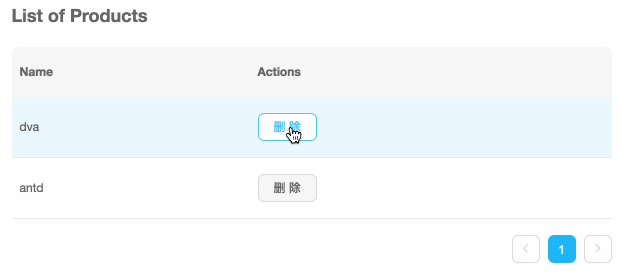7.4 KiB
| order | title |
|---|---|
| 3 | Real project with dva |
dva is a React and redux based, lightweight and elm-style framework, which supports side effects, hot module replacement, dynamic on demand, react-native, SSR. And it has been widely used in production environment.
This article will guide you to create a simple application from zero using dva and antd.
Include the following:
Install dva-cli
Install dva-cli with npm, and make sure the version is larger than 0.7.0.
$ npm install dva-cli -g
$ dva -v
0.7.0
Create New App
After you have installed dva-cli, you can have access to the dva command in terminal (can't access?). Now, create a new application with dva new.
$ dva new dva-quickstart
This creates a dva-quickstart directory, that contains the project directories and files, and provides a development server, build script, mock service, proxy server and so on.
Then cd to the dva-quickstart directory, and start the development server.
$ cd dva-quickstart
$ npm start
After a few seconds, you will see the following output:
Compiled successfully!
The app is running at:
http://localhost:8000/
Note that the development build is not optimized.
To create a production build, use npm run build.
Open http://localhost:8000 in your browser, you will see the dva welcome page.
Integrate antd
Install antd and babel-plugin-import with npm. babel-plugin-import is used to automatically import scripts and stylesheets from antd on demand. See repo 。
$ npm install antd babel-plugin-import --save
Edit .roadhogrc to integrate babel-plugin-import.
"extraBabelPlugins": [
- "transform-runtime"
+ "transform-runtime",
+ ["import", { "libraryName": "antd", "style": "css" }]
],
Notice: dva-cli's build and server is based on roadhog, view roadhog#Configuration for more
.roadhogrcConfiguration.
Define Router
We need to write an application displaying the list of products. The first step is to create a route.
Create a route component routes/Products.js:
import React from 'react';
const Products = (props) => (
<h2>List of Products</h2>
);
export default Products;
Add routing information to router, edit router.js:
+ import Products from './routes/Products';
...
+ <Route path="/products" component={Products} />
Then open http://localhost:8000/#/products in your browser, you should be able to see the <h2> tag defined before.
Write UI Components
As your application grows and you notice you are sharing UI elements between multiple pages (or using them multiple times on the same page), in dva it's called reusable components.
Let's create a ProductList component that we can use in multiple places to show a list of products.
Create components/ProductList.js by typing:
import React from 'react';
import PropTypes from 'prop-types';
import { Table, Popconfirm, Button } from 'antd';
const ProductList = ({ onDelete, products }) => {
const columns = [{
title: 'Name',
dataIndex: 'name',
}, {
title: 'Actions',
render: (text, record) => {
return (
<Popconfirm title="Delete?" onConfirm={() => onDelete(record.id)}>
<Button>Delete</Button>
</Popconfirm>
);
},
}];
return (
<Table
dataSource={products}
columns={columns}
/>
);
};
ProductList.proptypes = {
onDelete: PropTypes.func.isRequired,
products: PropTypes.array.isRequired,
};
export default ProductList;
Define Model
After completing the UI, we will begin processing the data and logic.
dva manages the domain model with model, with reducers for synchronous state update, effects for async logic, and subscriptions for data source subscribe.
Let's create a model models/products.js by typing:
import dva from 'dva';
export default {
namespace: 'products',
state: [],
reducers: {
'delete'(state, { payload: id }) {
return state.filter(item => item.id !== id);
},
},
};
In this model:
namespacerepresent the key on global statestateis the initial value, here is an empty arrayreducersis equivalent to a reducer in redux, accepting an action, and update state simultaneously
Then don't forget to require it in index.js:
// 3. Model
+ app.model(require('./models/products'));
Connect
So far, we have completed a separate model and component. Then how do we connect them together?
dva provides a connect method. If you are familiar with redux, this connect is from react-router.
Edit routes/Products.js and replace it with the following:
import React from 'react';
import { connect } from 'dva';
import ProductList from '../components/ProductList';
const Products = ({ dispatch, products }) => {
function handleDelete(id) {
dispatch({
type: 'products/delete',
payload: id,
});
}
return (
<div>
<h2>List of Products</h2>
<ProductList onDelete={handleDelete} products={products} />
</div>
);
};
// export default Products;
export default connect(({ products }) => ({
products,
}))(Products);
Finally, we need some initial data to make the application run together. Edit index.js:
- const app = dva();
+ const app = dva({
+ initialState: {
+ products: [
+ { name: 'dva', id: 1 },
+ { name: 'antd', id: 2 },
+ ],
+ },
+ });
Refresh your browser, you should see the following result:

Build
Now that we've written our application and verified that it works in development, it's time to get it ready for deployment to our users. To do so, run the following command:
$ npm run build
After a few seconds, the output should be as follows:
> @ build /private/tmp/myapp
> roadhog build
Creating an optimized production build...
Compiled successfully.
File sizes after gzip:
82.98 KB dist/index.js
270 B dist/index.css
The build command packages up all of the assets that make up your application —— JavaScript, templates, CSS, web fonts, images, and more. Then you can find these files in the dist / directory.
What's Next
We have completed a simple application, but you may still have lots of questions, such as:
- How to deal with async logic
- How to load initial data elegantly
- How to handle onError globally and locally
- How to load Routes and Models on demand
- How to implement HMR
- How to mock data
- and so on...
You can:
- Visit dva official website.
- Be familiar with the 8 Conpects, and understand how they are connected together
- Know all dva APIs
- Checkout dva knowledgemap, including all the basic knowledge with ES6, React, dva
- Checkout more FAQ
- If your project is created with dva-cli , checkout how to Configure it